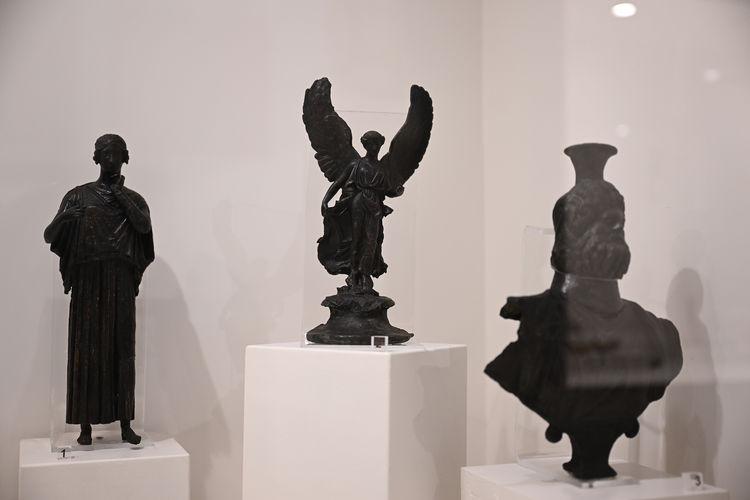The ancient city of Ainos is an important archaeological settlement located in the Enez district of Edirne province, at the point where the Meriç River flows into the Aegean Sea. Situated in a strategic position along the northern Aegean coast, Ainos played a significant role as a port city throughout history and came under the influence of various civilizations. While ancient sources date the city's foundation to the 7th century BCE, archaeological excavations have revealed that its history extends back to the Chalcolithic Age.

Nike figurine excavated from Ainos Ancient City (in the center, along with a Serapis statue and a bronze female statue) - Anadolu Agency
Location
The location of Ainos has made it an important center for trade and defense throughout history. The city is situated in a region bordered by the Black Sea to the north, the Aegean Sea to the south, the Sea of Marmara to the east, and Macedonia to the west. This position has turned Ainos into a crucial connection point between Asia and Europe. Ancient sources, particularly the works of Strabo and Stephanos Byzantinos, emphasize that Ainos was one of the most significant port cities along the Thracian coast.
Historical Development and Archaeological Findings
Ainos was initially founded by the Aeolians who settled in western Anatolia and is mentioned in Homer's Iliad as the center of the Thracian tribes. The city was largely influenced by Hellenistic and Roman cultures in antiquity but maintained its importance throughout the Byzantine period.
Stratigraphy
Archaeological excavations have revealed that Ainos consists of five distinct structural layers:
- Layer I: Thracian settlements (findings dating back to the Chalcolithic Age).
- Layer II: Aeolian settlements (7th century BCE and later).
- Layer III: Roman period structures.
- Layer IV: Byzantine period remains.
- Layer V: Ottoman period structures.
Among the significant structures uncovered in the excavations are a Greek structure carved into the bedrock dating back to the 6th century BCE, Aeolian column capitals, and various burial sites. The tombs found in the Water Balance Necropolis date back to the Archaic and Classical periods and contain Attic pottery, along with Corinthian and Orientalizing-style ceramics.
Architectural Remains
Excavations provide insight into the architectural landscape of Ainos in antiquity. The Aeolian settlement located in the acropolis is notable for its Aeolian column capitals, which are believed to have belonged to a large temple. Additionally, various cellar structures, water channels, and residential remains from the Hellenistic and Roman periods have been uncovered.
Ceramic and Coin Findings
Excavations at Ainos have brought to light a significant number of ceramics and coins, both produced locally and imported. Among the ceramic artifacts dating to the Late Hellenistic-Early Roman period are gray burnished pottery, red-figure amphorae, and imported sigillata ceramics. Moreover, gold coins from the Byzantine period indicate that Ainos remained an economically active center throughout the Middle Ages.
Cultural and Historical Significance of Ainos
Ainos functioned as both a political and economic center during Antiquity and the Middle Ages. It was an essential port city during the Ancient Greek and Roman periods and later became the administrative center of a region that included the islands of Imbros and Samothrace during the Byzantine Empire. The significance of the city during the Byzantine period is further reinforced by the discovery of gold coins and church structures.
The historical importance of Ainos is not only derived from its economic and political power but also from its cultural heritage. Figurines depicting mythological figures, mosaics, and sculptural fragments demonstrate that Ainos was a notable artistic center.
Ainos Ancient City is a settlement that carries traces of multiple civilizations throughout history, distinguished by its strategic location and archaeological discoveries. Excavations trace its past back to the Chalcolithic Age and confirm the architectural, economic, and cultural significance of Ainos in antiquity. Ongoing archaeological studies in the city today contribute to preserving its historical value for future generations. In this context, further archaeological excavations and restoration projects are necessary to examine Ainos from a broader perspective.


